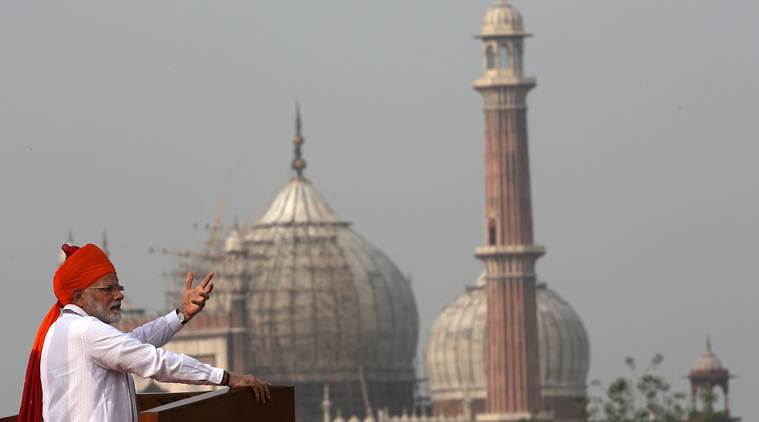 In his Independence Day speech, PM Modi referred to the WHO report as one of the certificates of the success of Swachh Bharat Mission. (Express Photo by Neeraj Priyadarshi)
In his Independence Day speech, PM Modi referred to the WHO report as one of the certificates of the success of Swachh Bharat Mission. (Express Photo by Neeraj Priyadarshi)
When Prime Minister Narendra Modi referred to a World Health Organisation report lauding Swachh Bharat Mission for saving the lives of 3 lakh babies in his Independence Day speech on Wednesday, he had overstated the facts, albeit by a small margin.
In a statement issued earlier this month, the global health body did shower high praise on the prime minister’s pet cleanliness drive, but with the proviso that should there be 100 percent implementation by 2019, only then 3 lakh child deaths would be averted. The exact words of the WHO statement were: “WHO lauds India’s commitment to accelerated coverage of safe sanitation services which, assuming 100% coverage is achieved by October 2019, could avert up to 300 000 deaths due to diarrheal disease and protein-energy malnutrition (PEM) since the country launched the Swachh Bharat Mission in 2014.”
Watch Video: PM Modi’s Independence Day speech
In his Independence Day Speech, while reiterating his government’s commitment to the cleanliness mission that he had first unveiled in his maiden speech from the ramparts of the Red Fort on August 15, 2014, Modi had referred to the WHO report as one of the certificates of the success of the mission. “World Health Organisation has said that 3 lakh deaths of babies have been averted by the Swachh Bharat Mission,” the prime minister said in his speech.
Follow Independence Day 2018 Live Updates
The conclusions had been reached from the initial results of a WHO modelling study on the health impact of the Swachh Bharat Mission Gramin (SBM-G). WHO analysed that India’s accelerated coverage of safe sanitation services, and its determination to end open defecation, would have a substantial effect on the burden of diarrheal disease and PEM by reducing mortality and accumulative Disability Adjusted Life Years (DALYs) – the sum of the years of life lost due to premature mortality and years lost due to disability or ill-health.
According to the calculations, if all sanitation services are used, the initiative could result in over 14 million more years of healthy life in the period measured, with the benefits accruing yearly thereafter. That, WHO said, is especially remarkable given that before 2014 unsafe sanitation caused an estimated 199 million cases of diarrhea annually, with modelling showing the problem will almost be eliminated when universal use of safe sanitation facilities is achieved.
Household sanitation coverage has dramatically increased from an estimated 2% per year before Swachh Bharat to more than 13% annually between 2016 and 2018. However, almost the entire WHO statement talks about the benefits of the sanitation programme in the future tense.
“Notably, the broader health impact of India’s commitment to accelerated sanitation coverage (which the present study does not consider) are likely to be significant. This includes improved overall nutritional status and reduced incidence of infectious diseases such as neglected tropical diseases and acute respiratory infections, as well as vector-borne diseases. Moreover, the estimations apply to the health impacts from improvements in sanitation coverage only, meaning it is possible that the broader Mission has produced additional health gains through changes in personal hygiene and the consumption of safe drinking water,” it says.